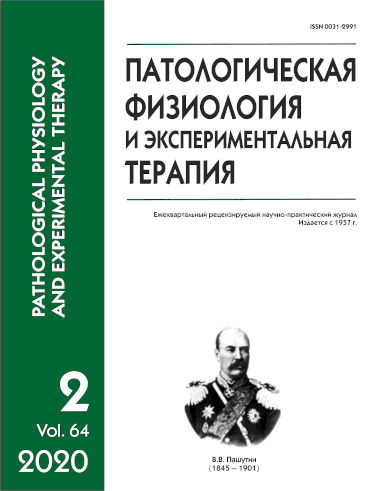Participation of bradykinin, cannabinoid, and vanilloid receptors in the infarct-limiting effect of adaptation to normobaric hypoxia
Abstract
Aim. Chronic moderate hypoxia is known to induce nonspecific myocardial resistance to ischemia-reperfusion injury. However, receptor-mediated mechanisms of this resistance are understudied. The aim of this study was to investigate the involvement of bradykinin, cannabinoid, and vanilloid (TRPV1 channel) receptors in development of the infarction-limiting effect of chronic normobaric hypoxia (CNH). Methods. The study was performed on male Wistar rats exposed to CNH at 12% pO2 and 0.3% pCO2 for 21 days. Coronary occlusion was induced by ligation of the left descending coronary artery at the upper third of the artery for 45 min, which was followed by 2-h reperfusion produced by releasing the ligature under visual control of the recovery of coronary blood flow by hyperemia of the ischemic area. For detection of the area at risk, the ligature was tightened again, and 5% potassium permanganate solution was infused into the aorta to stain the nonischemic myocardial area. 2-mm sections of the left ventricle were stained with 1% solution of 2,3,4-triphenyl tetrazolium (37°С, 30 min). Necrotic area and area at risk were measured planimetrically with the tEllipse 2.02 (ViDiTo, Czech Republic) software. Cannabinoid CB1 and CB2 receptors were inhibited with their respective antagonists, rimonabant (1 mg/kg) and AM630 (2.5 mg/kg); bradykinin B2 receptors were inactivated with the selective antagonist HOE140 (50 μg/kg); and vanilloid receptors (TRPV1 channels) were inhibited with capsazepine (3 mg/kg). All antagonists were administered 15 minutes prior to coronary occlusion. Results. The size of necrotic area was 33% of the area at risk in rats adapted to hypoxia vs. 53% in non-adapted rats. This infarct-limiting effect of adaptation to hypoxia was abolished by inhibition of B2-bradykinin receptors. Blockade of cannabinoid or vanilloid receptors did not change the infarct-limiting effect of CNH. Therefore, the infarction-limiting effect of CNH depends on activation of bradykinin B2 receptors but not of cannabinoid or vanilloid receptors. Conclusion. Activation of bradykinin receptors can be considered a key mechanism of the infarct-limiting effect of CNH. Since opioid receptors are known to play an important role in CNH cardioprotection, the infarct-limiting effect of CNH may be mediated by Gi/o-coupled opioid and bradykinin receptors. Cannabinoid receptors and TRV1-channels do not contribute to the infarct-limiting effect of adaptation to normobaric hypoxia.






